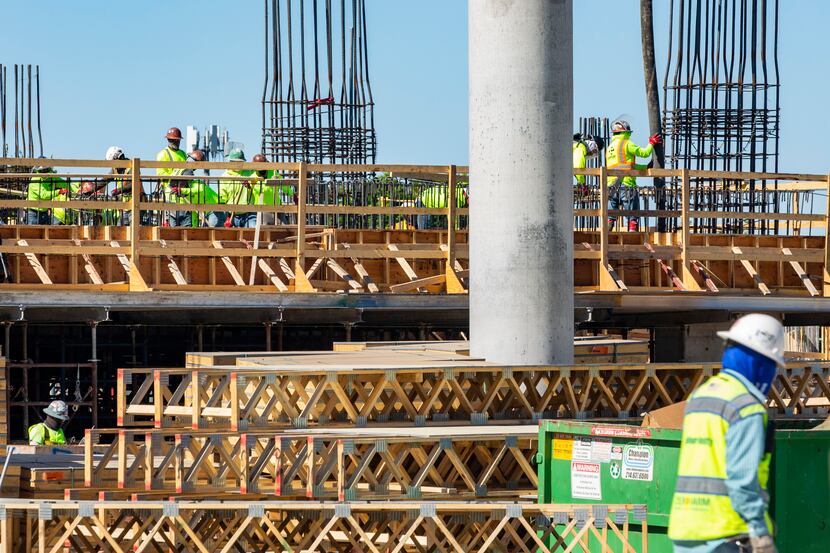Texas added 34,400 nonfarm jobs in May as the economic recovery continued at a choppy pace, and the state’s unemployment rate ticked down to 6.5%, the Texas Workforce Commission reported on Friday.
Job gains in May were more than double the hiring in April, but the percentage increase in Texas was smaller than what the U.S. reported for the same month. Texas’ job numbers in May were also far short of the 109,700 employees added in March.
“The bounce we saw in March has not been sustained, and we’re on a slower job growth trajectory than we had hoped,” said Pia Orrenius, senior economist at the Federal Reserve Bank of Dallas. “We’re finally just coming to the realization that we may not get back all our lost jobs this year, which is a disappointment.
“It doesn’t have much to do with May [results]. It’s just an accumulation of the evidence that we’re not going to get the huge numbers we were hoping for,” she said.
The Dallas Fed had been projecting that Texas would add over 800,000 jobs this year and recoup all the employment lost during the pandemic. On Friday, it lowered the full-year forecast to 510,500 jobs.
The downward revision was primarily due to an anticipated increase in COVID-19 hospitalizations next fall. The pace of vaccinations has slowed, and the more contagious Delta variant is spreading, Dallas Fed senior economist Keith Phillips wrote in the updated forecast on Friday.
During the pandemic, rising hospitalizations have correlated with a weaker recovery, he said.
If the Dallas Fed projection is correct, Texas would end the year with about 143,000 fewer jobs than before the pandemic — and a full labor market recovery won’t happen until next year.
Over 920,000 Texans were unemployed in May, which was still 77% higher than in February 2020, before the pandemic arrived. Texas’ seasonally adjusted unemployment rate of 6.5% easily surpassed the U.S. rate of 5.8%, and Texas has had a higher jobless rate than the U.S. every month since September.
But general economic indicators remain solid, and the Texas Leading Index continued to increase strongly in May, the Dallas Fed reported.
There’s great demand in the market, Orrenius said, but many workers are staying on the sidelines. Some remain worried about COVID and variants; others want to explore career options and retraining; and some continue to struggle with finding child care.
“The takeaway is that, for all these reasons, people are just taking longer to get back into the labor force,” Orrenius said. “It looks like the transition to the new normal will take a while.”
Texas has added 195,700 jobs so far this year with monthly changes varying widely.
Leisure and hospitality, which includes the hard-hit restaurant and hotel businesses, added 14,200 jobs from April to May, the largest percentage gain among the big employment sectors. Professional and business services added 13,800 jobs last month, and manufacturing added 3,200.
Mining and logging, which includes the oil and gas business, added 1,600 jobs statewide last month — after losing slots in April.
One negative surprise was in construction, which lost 3,100 jobs in May, according to the workforce commission.
Residential real estate has boomed during the pandemic, and home prices have climbed to record highs. But there’s pressure on the commercial side, in part because of concerns that more employees will continue to work from home, reducing demand for office space.
“It’s two different stories — residential real estate is getting jobs and doing much better, and nonresidential is not,” said Luis Torres, research economist at the Texas Real Estate Research Center at Texas A&M University.
“But it always surprises me to see a negative number in construction, and it’s hard to believe we lost another 3,100 jobs.”
In April, Texas lost over 13,000 jobs in construction, according to the workforce commission.
Torres pointed to nationwide job losses in heavy and civil engineering construction. That reflects declines in building oil and gas pipelines, power and communication systems, and water and sewer systems, he said.
He also cited financial pressures on city and county governments and school districts, which may be cutting their construction spending. Texas lost 2,500 jobs in government last month.
Torres attributed Texas’ slow job growth to companies having trouble finding workers. That’s likely to change by early fall, he said, assuming that schools and child care centers reopen, and demand for services and products remains strong.
“There will be no more excuses,” Torres said.

